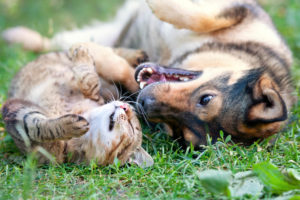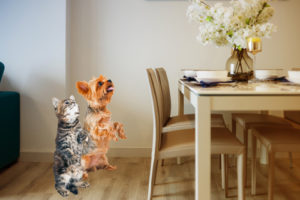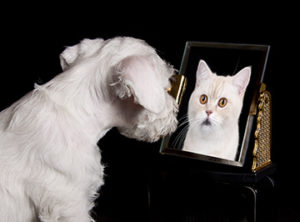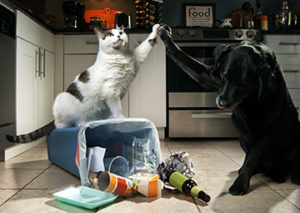If the animal you thought was a dog displays these 5 cat characteristics, you in fact have a feline in your lap:
1. Curiosity
Does your dog ever just sniff your face? It’s gentle and sweet, but also wet. When cats sniff up close and personal, it is due to their curiosity in you and your overall smell. Cats love to explore the small, dark, enclosed spaces that small rodents like to hide in, and they can’t resist testing the limits of their ability to contort themselves into impossibly tight squeezes. Our homes contain a world of smells that your dog is absolutely dying to investigate, which is why they’ll find themselves stuck in many cat-like predicaments (or busted in the midst of a trash can investigation) due to their underrated cat-like curiosity.
2. Going to their back

Cats and their unladylike legs-open sprawl is a sign that cats are happy, trusting, and comfortable with you. However, they remain ever ready to spring into action, and their ears will perk up when they hear a sound that disturbs their peace. Dogs are pack animals that establish a hierarchy for each dog, and going to their backs is their way of signalling submission to a more dominant dog. It’s still a vulnerable position, but going to the back for a dog seems to evolve into more of a sign of trust, security, and playfulness, like a cat, than it is a form of submission. Does this sound like a dog you know?
 3. Talkative
3. Talkative
It’s believed that cats only meow to communicate with people. The most common is the repetitive or whining meow that says “I’m hungry. Feed me now!” and it works. Dogs will communicate vocally with any animal, person, or even a vacuum cleaner, to let their feelings known. Some dogs have taken a page out of the cat playbook and expanded their vocabulary to get in on the “feed me now” action. They give their owners an all-too-cute whimper near their bowl, or food storage, or your slice of pizza, to let you know that they could go for something, anything, to eat.
4. Hunting play

That random burst of energy when your four-legged friend sprints around the house, or “zippy zooms,” as we call it at home, is a very cat-like behavior. The play behavior of many animals is a form of practice for “real world” skills they need to be successful. Cats are programmed to enjoy the bursts of speed and claw quickness they need to catch small, quick prey. Many dogs were bred to chase or retrieve small animals, and they, too, share an affinity for the cat-like thrill of the chase. In fact, most dogs were bred for tasks that require a lot more energy than the average non-working pet expends in a day. So it’s important to incorporate enough mental and physical play into their regular routine to help them burn off all the extra energy and use the skills they were born to display.
5. Seat thieves and perch sitters
According to your cat, no place is as comfortable as the seat you just warmed up with your behind. Similar to a furry friend basking in a sunbeam for the heat, your cat will swipe your spot on the couch the minute you get up for a quick drink of water. A cat-like dog also emulates their feline counterpart when they swipe your seat for the warmth, plus the comfort of your distinctive smell. Some dogs will also perch on high surfaces, such as the top of a couch. Like a leopard in a tree surveying the savanna, these dogs get to observe all that is happening in the living room. Some like to sit on the windowsill to patrol the neighborhood from their throne, and bark at anyone who walks too close to the mailbox.
Even if you’re a dyed-in-the-wool dog person, there’s nothing wrong with a dog that is in touch with his or her feline side. That said, when it is time to engage the wolf that lies within your dog’s DNA, you might want to consider these natural chews and treats to satisfy your dog’s ancient cravings.




